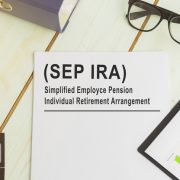Why a Self-Directed SEP IRA Over the Rest?
You may notice quite a few different types of IRAs available at American IRA. You can hold a Traditional IRA, a Roth IRA, or even other accounts like Solo 401(k) plans. So why would you choose a Self-Directed SEP IRA as opposed to the others? What does this account hold as a natural advantage that the other’s don’t? It’s a clear question—but with an answer of many parts. So let’s break it down by looking at some of the specific reasons investors might use a Self-Directed SEP IRA.
The Self-Directed SEP IRA: The Basics
Let’s start by explaining what a SEP IRA is. Also known as a Self-Directed Simplified Employee Pension IRA, this is an account which entrepreneurs and company owners can use to build retirement benefits.
One of the standout features of a Self-Directed SEP IRA is its flexibility. Unlike a lot of conventional employer-sponsored retirement plans, such as 401(k)s, a SEP IRA offers employers some more freedom. You can use it to decide whether and how much they contribute each year. This flexibility is particularly helpful for businesses with fluctuating income—like if you’re a freelancer—or maybe entrepreneurs looking to manage their cash flow more effectively.
Of course, everyone’s tax situation is different, so make sure that you’re able to consult with a tax professional to ensure that a SEP IRA is right for you.
Why Hold a SEP IRA? Tax Benefits Galore
Tax advantages are a significant draw for any retirement account. A Self-Directed SEP IRA is no exception. Contributions made to a SEP IRA are tax-deductible, reducing the taxable income for both employers and employees. This tax-deferred growth can significantly bolster retirement savings over time. You’re able to put more money aside while realizing immediate tax savings in the here and now—which is a major draw to many retirement accounts.
Additionally, the contribution limits for a SEP IRA are generous. You can contribute up to 25% of your income potentially, though make sure that you consult with a tax professional to make sure this situation applies to you. For self-employed individuals, the calculation is equally straightforward—you’re considered both the employer and the employee, giving you the opportunity to maximize your contributions.
Investment Freedom with a Self-Directed SEP IRA
We haven’t even talked about self-direction yet. Perhaps the most compelling feature of a SEP IRA is the freedom it provides you. You can use these accounts to invest in the full range of retirement asset classes available to you—such as real estate, precious metals, and even private company stock. (And those are just three highlights.)
This freedom in your investment portfolio allows you to diversify beyond traditional asset classes. After all, investing in alternative assets can provide unique opportunities for growth and income generation that may not be available through conventional investment choices.
A Self-Directed SEP IRA offers unparalleled flexibility. It offers tax benefits. It offers investment freedom. And it’s an attractive option for employers, self-employed individuals, freelancers, and small business owners alike. Whether you’re looking to optimize your retirement savings, maximize tax deductions, or simply explore alternative investments, a Self-Directed SEP IRA can help.
That leads to one question: what’s next?
We recommend continuing your research by reaching out to us here at American IRA. Interested in learning more about Self-Directed IRAs? Contact American IRA, LLC at 866-7500-IRA (472) for a free consultation. Download our free guides or visit us online at www.AmericanIRA.com.











